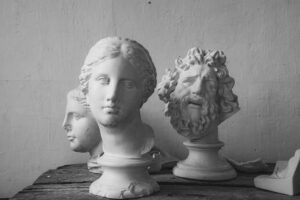Art has been a part of human history since the beginning of time. From the earliest cave paintings to modern-day masterpieces, art has evolved and transformed into something truly remarkable. The evolution of art is an incredible journey that showcases humanity’s creative prowess and imagination throughout history. In this blog post, we will take a trip through time, exploring the different eras of art – from prehistoric times to contemporary works – and how they have influenced each other over time. So let’s delve deep into the world of art and discover its fascinating evolution!
Prehistoric Art
Prehistoric art refers to the earliest forms of human artistic expression, dating back more than 30,000 years ago. The most famous examples of prehistoric art are cave paintings found in various parts of the world, including Europe, Asia and Africa.
These cave paintings depict animals such as bison, horses and deer using natural pigments made from minerals mixed with water or animal fat. They were created by early humans who lived a nomadic lifestyle and relied on hunting for their survival.
The purpose behind these cave paintings is still debated by experts today. Some believe they served as a form of storytelling or communication between different groups of early humans. Others suggest they may have had religious significance or been used for spiritual rituals.
Regardless of their purpose, prehistoric art provides us with valuable insights into the lives and beliefs of our ancestors. It also shows that even in the earliest stages of human history, we had an innate desire to express ourselves through creative means.
Ancient Art
Ancient art refers to the visual arts that were created in various civilizations and cultures before the Middle Ages. This period is characterized by a wide range of art styles, techniques, and mediums that reflect the social, political, religious, and cultural contexts of their respective eras.
One of the most prominent examples of ancient art is Egyptian Art. The Egyptians had an extensive artistic tradition spanning over 3000 years which included architecture, sculpture, painting and decorative arts. Egyptian artists had a highly stylized approach to representations with each element having symbolic meanings.
Another significant contribution to ancient art was made by Greek artists whose works are marked by their realism compared to their predecessors. Ancient Greek pottery has vibrant imagery depicting scenes from mythology or everyday life events like sports or farming.
The Romans also left behind magnificent artworks such as sculptures celebrating emperors’ achievements through monumental arches commemorating military victories.
Other notable contributors include China with its imperial porcelain creation technique while India boasts some impressive cave temples adorned with wall paintings featuring deities from Hinduism or Buddhism.
Ancient art remains an essential reference point for contemporary artists today who draw inspiration from these timeless masterpieces.
Classical Art
Classical Art refers to the art produced in ancient Greece and Rome between the 5th century BC and the 4th century AD. It is known for its idealized depictions of figures, realistic portrayals of emotions, and themes that often focused on mythology.
One of the most notable features of Classical Art is its emphasis on balance and harmony. The human body was a popular subject matter, with artists striving to capture it in motion or at rest while maintaining perfect proportions.
The techniques used by classical artists have had a lasting impact on Western art. For instance, contrapposto – the asymmetrical pose where one leg bears more weight than the other – became particularly popular during this period.
Another distinctive aspect of Classical Art is its preference for marble as a material for sculptures. Marble allowed artists to create intricate details such as flowing garments or delicate facial expressions.
Classical Art remains an important part of our cultural heritage due to its influence on modern aesthetics and artistic traditions.
Modern Art
Modern art emerged in the late 19th century and continued to evolve throughout the 20th century. This period was marked by a break from traditional techniques and styles, as well as an increased focus on individual expression.
One of the most significant movements of modern art was Cubism, which evolved in the early 1900s. Artists such as Pablo Picasso and Georges Braque created works that broke down objects into geometric shapes and fragmented forms.
Another influential movement was Abstract Expressionism, which developed in America after World War II. Artists like Jackson Pollock used spontaneous gestures to create large-scale abstract canvases that conveyed emotion through color and texture.
Pop Art also emerged during this time, featuring bright colors, bold graphics, and imagery drawn from popular culture. Andy Warhol became one of the most famous pop artists with his colorful prints of celebrities like Marilyn Monroe.
Modern art continues to evolve today with new media such as digital technology influencing artistic expression. Younger generations are experimenting with new mediums like video installations or performance art to push boundaries even further than their predecessors did.
Contemporary Art
Contemporary art is a broad term used to describe art produced in the present time, typically from the 1960s onwards. It encompasses a wide range of styles and media, including painting, sculpture, installation art, performance art and digital art.
One of the defining characteristics of contemporary art is its focus on conceptual rather than aesthetic concerns. Artists working in this genre are often more interested in exploring ideas and issues than producing beautiful objects. This can sometimes make contemporary art challenging or even confrontational for viewers.
Another key trend within contemporary art is an increased interest in interdisciplinary work that blurs traditional boundaries between different disciplines such as music, dance and visual arts. Many artists use new technologies to create multimedia installations that incorporate sound, video and interactive elements.
Contemporary artworks also frequently address social and political issues such as gender identity, race relations and environmentalism. Some artists have used their work to critique consumer culture or challenge established power structures.
Contemporary art remains a vibrant and diverse field with many exciting developments emerging all the time.
The Future of Art
As we move further into the 21st century, it’s hard to predict exactly what the future of art will look like. However, we can make some educated guesses based on current trends and developments in technology.
One thing that is likely to continue shaping the world of art is digital media. As technology advances, artists are finding new ways to create and showcase their work using tools like virtual reality and augmented reality. This has opened up exciting new possibilities for immersive installations and interactive exhibitions.
Another trend that may gain momentum in the coming years is art with a purpose beyond aesthetics. Many contemporary artists are already using their work to comment on social issues or raise awareness about important causes. In the future, we may see more artists using their platform to effect real change in society.
As our world becomes increasingly connected through globalization and technology, it’s possible that we’ll see a blending of different artistic traditions from around the globe. This could lead to fascinating combinations of styles and techniques that break down cultural barriers and bring people together through shared appreciation for beauty.
While it’s impossible to know exactly what lies ahead for the world of art, there are plenty of reasons to be excited about its potential evolution in the years to come!
Conclusion
Art has been an integral part of human history, and its evolution is nothing short of remarkable. From the simple cave paintings that were done for survival to contemporary masterpieces that are now highly sought after by collectors worldwide, art continues to evolve.
Through different eras and civilizations, art reflects not only the culture but also the beliefs and aspirations of humanity. It’s a language that transcends time and space, connecting people from different backgrounds.
As we look back at the evolution of art from prehistoric times to modern-day works, it’s evident that artists have always strived to push boundaries and create something new. The future holds even more possibilities as technology continues to influence how we perceive and create art.
The journey of art is far from over; it’s one that will continue into infinity as long as there are humans on this planet creating it. Artistic expression will never cease because they reflect our inner selves in ways beyond words.
So let us celebrate every era’s contribution towards this beautiful world of visual arts – be it ancient or modern!








